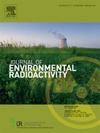基于氡示踪和人工神经网络的岩石破裂强度综合预测方法
IF 2.1
3区 环境科学与生态学
Q3 ENVIRONMENTAL SCIENCES
引用次数: 0
摘要
在地质和工程实践中,确定岩体的断裂强度对石油、天然气、铀和地热能等资源的开采至关重要。由于缺乏直接测量岩石裂缝分布的技术手段,岩石断裂强度的获取非常困难。提出了一种基于人工神经网络和氡示踪的岩石断裂强度综合预测方法。首先,建立了氡运移模型,数值模拟了不同断裂参数下裂隙岩体的氡呼出速率;该模型采用离散裂缝网络(DFN)生成岩石裂缝。利用该模型对900组数据进行了数值计算,作为人工神经网络的学习数据。该方法具有较好的预测精度,决定系数为0.907。隐层数和神经元数是决定模型预测精度的关键因素。最后,利用该模型对露头裂隙岩体的断裂强度进行了预测。预测断裂强度与实测值接近,差值为7.5%。本文章由计算机程序翻译,如有差异,请以英文原文为准。
Integrated approach to predicting rock fracture intensity based on radon tracing and artificial neural network
In geological and engineering practices, determining fracture intensity of rock masses is critical for the exploitation of resources such as oil, natural gas, uranium, and geothermal energy. Due to the lack of technological means to directly measure the distribution of rock fractures, it is very difficult to obtain the rock fracture intensity. This paper proposes an integrated approach to predicting rock fracture intensity based on artificial neural network (ANN) and radon tracing. Firstly, a radon migration model was established to numerically simulate radon exhalation rate of fractured rock masses under different fracture parameters. In the model, rock fractures were generated using the discrete fracture network (DFN). 900 sets of data were numerically calculated as learning data for the ANN using the model. The proposed method has good prediction accuracy with a coefficient of determination of 0.907. The number of hidden layers and neurons are key factors determining the accuracy of model prediction. Finally, the model was used to predict the fracture intensity of a fractured rock mass with outcrop. The predicted fracture intensity is close to the measured value, with a difference of 7.5 %.
求助全文
通过发布文献求助,成功后即可免费获取论文全文。
去求助
来源期刊

Journal of environmental radioactivity
环境科学-环境科学
CiteScore
4.70
自引率
13.00%
发文量
209
审稿时长
73 days
期刊介绍:
The Journal of Environmental Radioactivity provides a coherent international forum for publication of original research or review papers on any aspect of the occurrence of radioactivity in natural systems.
Relevant subject areas range from applications of environmental radionuclides as mechanistic or timescale tracers of natural processes to assessments of the radioecological or radiological effects of ambient radioactivity. Papers deal with naturally occurring nuclides or with those created and released by man through nuclear weapons manufacture and testing, energy production, fuel-cycle technology, etc. Reports on radioactivity in the oceans, sediments, rivers, lakes, groundwaters, soils, atmosphere and all divisions of the biosphere are welcomed, but these should not simply be of a monitoring nature unless the data are particularly innovative.
 求助内容:
求助内容: 应助结果提醒方式:
应助结果提醒方式:


